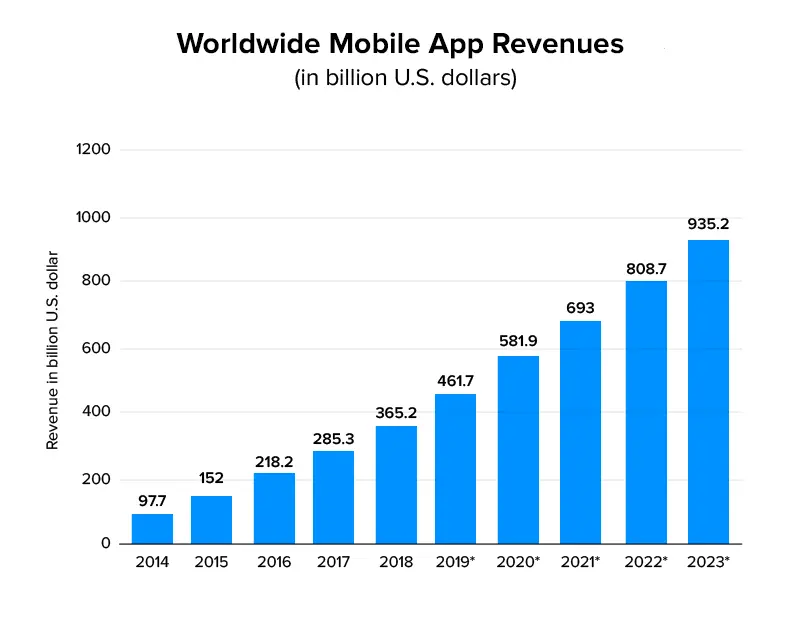

The open-source Flutter SDK is a Google UI toolkit that creates attractive, natively compiled mobile apps, from a single codebase.
With apps being downloaded and used by millions of people in a rapid way, the mobile app development is skyrocketing.
There are many companies that are making use of this trend and contributing to the increase of app downloads. Here are some facts:
In 2020, global mobile app revenues were over 581 billion U.S. dollars. In 2023, mobile apps are projected to generate more than 935 billion U.S. dollars in revenues via paid downloads and in-app advertising.

After reading the above facts and data, it is clear that the app development market is rapidly growing, and mostly the startups are taking the lead in developing apps like enterprise apps with flutter and increasing their reach. If you have an idea and are confused about which platform to use, the best suggestion would be mobile app development with Flutter.
As they say, numbers never lie. Let us look at some data revolving around Flutter app development services:
Flutter cross-platform application development is a huge buzz creator due to its “Hot Reloading” or “Hot Restart” features. With the help of this feature developers are able to write codes and finish the project development in real-time. As a result, coders increase their productivity and save a lot of valuable time.
Flutter integrated apps provide a wide range of widgets including navigation, scrolling, fonts, and icons that are customizable regardless of the screen size. These widgets are easy to customize and make the app development process fast and simple.
The reason why Flutter is trending is because of its ‘write-once’ approach. Writing multiple codes for different platforms is no longer significant. Flutter mobile app developers only have to code once and not separately for both operating systems, that is Android and iOS, that is why Flutter is considered by most of the developers. As a result, Flutter makes the app development process as cost–effective as possible.
Flutter can customize almost anything visible on your startup app. Be it shapes, colors, shadows, clipping or transforming elements, Flutter allows developers to execute everything seamlessly. Hence, it is needless to say that Flutter makes the app development process flexible and simple without adding extra workload.
Flutter allows the creation of serverless apps. Developers can use Google’s firebase support as back end and create serverless startup apps. Flutter provides a quick development cycle to help developers achieve their targeted time frames.
If startup app development companies choose Flutter, then it’s the correct choice made. Flutter eliminates the struggle of time constraint and limited budget faced by startups trying to release apps across multiple platforms. Also, it is a blend of all the best Google ideas and technologies, a mixture which results in the creation of a powerful mobile framework.
This one is a cliché but don’t all great applications begin with an out of the box idea? Once you have an idea, you need to conduct a market research and find out your target audience. If you wish to create an app then don’t just begin blindly; instead, dig deep and research the facts, concepts and competitors. It is always important to find out how you are better than your competitors.
A minimum viable product or MVP acknowledges business owners to validate their idea, gather feedback, and identify customer’s needs. MVP is useful in avoiding market failure and investing on a product that is not backed up by proper market surveys and research.
Being an open source, Flutter complements MVP development. With Flutter increasing the pace of the development process, the process has become more simplified and efficient. Also, Flutter’s compatibility with Firebase, doesn’t require you to separate backends for building simple MVP. Creating MVP with flutter provides an added benefit of delivery of an intricately designed solution.
Flutter not only provides us with native performance and hot reload for fast development but also access to beautiful, native components. The Flutter toolkit has opened a gateway to allow for a multitude of UI/UX and, by using its own source code, eliminating platform limitations.
Flutter is becoming an all-platform framework. What about when you want to use your startup app or a smaller or a bigger device? Be it a smartwatch, TV, laptop or smartphone. So, you can build native mobile apps using flutter to provide a wider range of devices that the app can function on.
There is no need to build separate code for a multitude of devices, as Flutter already supports that using a single code-base. There are packages you can rely on which are equipped with native iOS & Android widgets to help your app give a platform-specific look.
Startup mobile app development is a highly interactive process. The process includes- planning, development, coding, testing and reviewing. This is the step where you must look out for a Flutter mobile app company that can develop an android app using Flutter.
Flutter app development cost is typically efficient and scalable in comparison to other cross platform frameworks.
Mobile app development comprises three integral parts that are – backend, API and mobile app front end.
The current app development market is extremely competitive! In order to make a new app stand out within a limited budget, the product should be extraordinary enough to drive the attention of the crowd.
If you are launching your startup app, Flutter is the platform to choose as it allows you to develop user-friendly apps across multiple platforms in a cost-effective way. Unlike other platforms, Flutter app developers create apps with a smooth UI for their users.
Flutter is an open-source UI software development kit (SDK) created by Google. It allows developers to build cross-platform applications using a single codebase that runs natively on multiple platforms, including Android, iOS, web, and desktop.
The first step in Flutter app development is to come up with an idea for the app. This is followed by conducting market research, identifying the target audience, and analyzing competitors to understand how the app can stand out.
Mobile app development is skyrocketing due to the increasing number of people downloading and using apps. The widespread adoption of smartphones and the convenience they offer have led to a surge in demand for mobile applications across various industries.
Flutter allows developers to customize almost any visible element on a startup app, including shapes, colors, shadows, clipping, and transformations. This flexibility makes the app development process more user-friendly and eliminates the need for additional workloads.
Flutter is a suitable choice for startups with limited budgets because it eliminates the need to develop separate codebases for different platforms (Android and iOS). With a single codebase, startups can save costs and still develop user-friendly apps across multiple platforms, making efficient use of their resources.